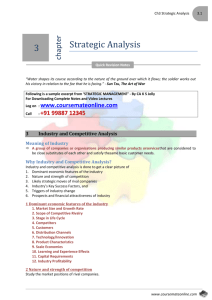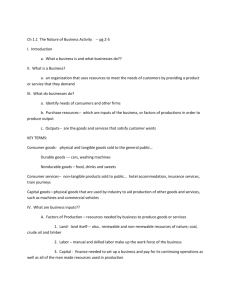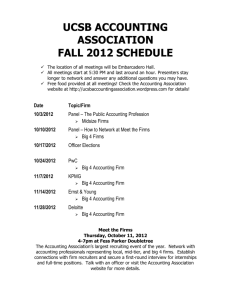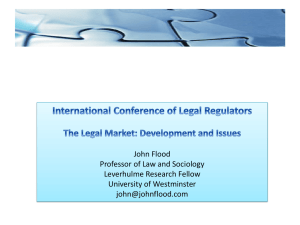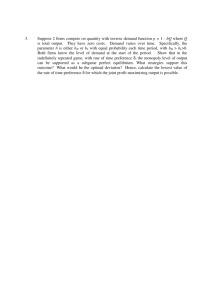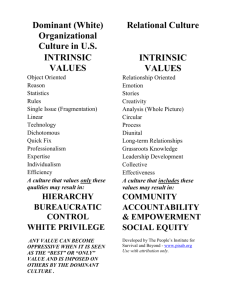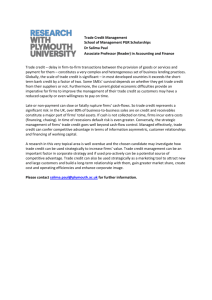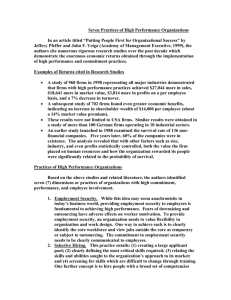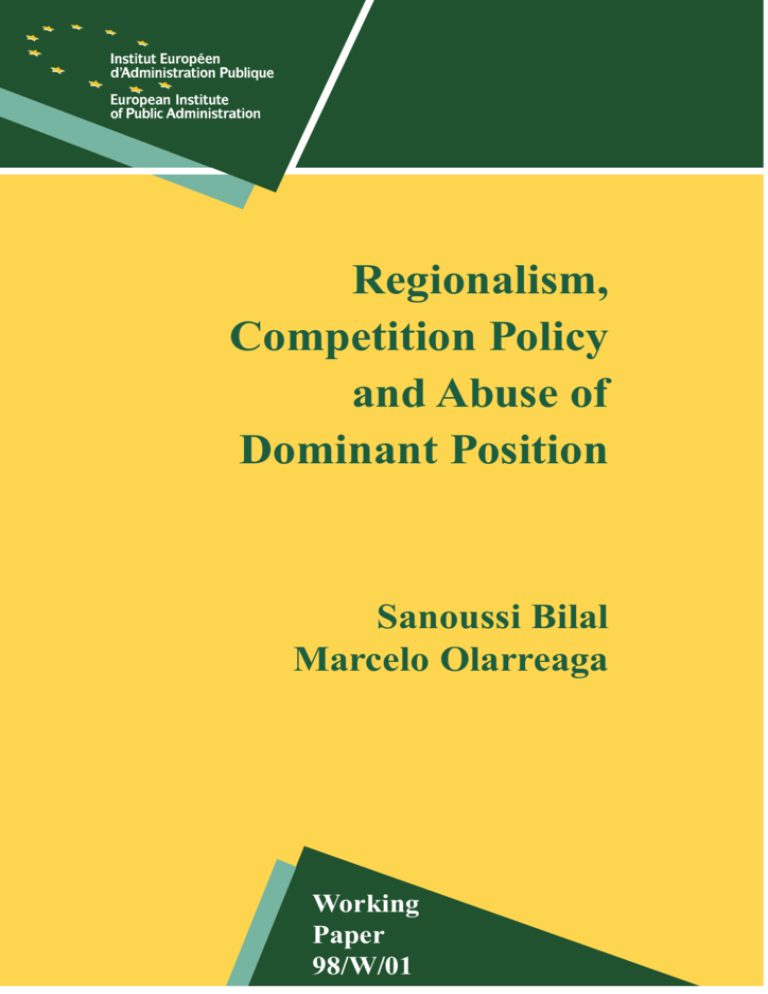
Regionalism,
Competition Policy
and Abuse of
Dominant Position
Sanoussi Bilal
Marcelo Olarreaga
Working
Paper
98/W/01
© EIPA
Regionalism, Competition Policy and Abuse of Dominant Position
1
© EIPA
98/W/01
© 1998, European Institute of Public Administration.
All rights reserved. No part of this publication may be reproduced, stored in a
retrieval system, or transmitted in any form or by any means, mechanical,
photocopying, or otherwise, without prior written permission of the publisher,
European Institute of Public Administration, O.L. Vrouweplein 22, P.O. Box 1229,
6201 BE Maastricht, the Netherlands.
Typeset and printed by the Publications Service, EIPA, the Netherlands.
2
© EIPA
Regionalism, Competition Policy and
Abuse of Dominant Position*
Sanoussi Bilal**
Marcelo Olarreaga***
May 1998
Abstract
Co-ordination of competition policies within regional trade agreements
(RTAs) seems desirable, especially within deeper forms of regional
integration. This contributes to a healthy and stable regional trading system.
We argue, however, that regional competition policies should be carefully
elaborated not to neglect efficiency considerations linked to economies of
scale/scope within a regional liberalisation program, in particular, in the
case of dominant positions. We also suggest that, in the short term, a less
stringent approach to competition policy should be adopted in RTAs among
developing countries where market failures may be due not only to
imperfect competition but also to credit and labour market constraints.
(JEL F13, F15, L40)
Key Words: competition policy, regionalism.
*
We gratefully acknowledge helpful comments by Emmanuel P. Mastomanolis, Petros
C. Mavroidis, Jaime de Melo and Aad van Mourik. An earlier version of this paper was
prepared for the CEFIR-EIPA conference on Competition Policies and Regional
Integration held in Montevideo on the 8-10 September 1997. The views expressed here are
those of the authors solely and do not necessarily reflect those of the institutions to which
they are affiliated.
**
European Institute of Public Administration, P.O. Box 1229, 6201 BE Maastricht, The
Netherlands, e-mail: sbi@eipa.nl.
***
Economic Research, World Trade Organization, 1211 Geneva 21, Switzerland, and
CEPR, London, UK, e-mail: marcelo.olarreaga@WTO.org.
3
© EIPA
1.
INTRODUCTION
Recent years have experienced simultaneously the globalisation of the world
economy, illustrated both by the conclusion of the Uruguay Round
Agreement, and the resurgence of regionalism, with the deepening and
widening of the European Union (EU), the creation of the North American
Free Trade Agreement (NAFTA) and the Common Market of the Southern
Cone (MERCOSUR), among others. Trade liberalisation tends to enhance
the competitive climate within and among countries. Indeed, by lowering its
trade barriers, a country opens its market to foreign competitors. Such
increase in market access is likely to break up oligopolistic structures in the
domestic economy. In many respects, trade policy and competition policy
can be considered as substitutes to the extent that they are two policy
instruments affecting market openness and market structure.
However, trade and competition policies are only imperfect substitutes,
except perhaps in the case of small open economies, where competitive
pressure from foreign suppliers may suffice to yield a high degree of
competition in the domestic market. Some authors have also argued that
theoretically there is a case for trade liberalisation and competition policy to
be complements. Indeed, the topsy-turvy principle of implicit collusion
argues that anything that makes a market more competitive (as trade
liberalisation) may actually result in more collusive behaviour by firms. The
idea is that as the market becomes more competitive, firms will try to enter
into strategic agreements to keep their profit level at a sufficiently high
level. There is some evidence in the EU, NAFTA and MERCOSUR that
such a phenomenon has occurred during the integration process (see
Hodara, 1992 for example). The reinforcement of dominant position within
regional trading blocks may call for a cautious approach to regional
competition policy. Section 2 of this paper develops some of the problems
related to the abuse of dominant positions and its legislation.
If it is not clear whether an international competition policy agreement is
needed in a forum such as the World Trade Organization (WTO), there is a
stronger case for the introduction of a regional competition policy authority
within regional integrating areas. In particular, in the case of deep forms of
regional integration such as customs unions and common markets, the need
for a common competition policy approach is stronger. The reason is that
regional integration reinforces the arguments in favour of a common
competition policy whereas many of the arguments against an international
4
© EIPA
approach to competition loose their significance (or vanish) in the case of
regionalism. This point of view is developed in Section 3.1
Section 4 discusses the case for a regional approach to competition policy in
the presence of abuse of dominant position. However, we call for a less
stringent approach in the case of regional integration process among
developing countries which should be closer in spirit to the US legislation
on abuse of dominant position (Section 2 of the Sherman Act) than to the
EU legislation (Article 86 of the EU Treaty). The reason is that the focus of
EU competition is rather on competition per se rather than on efficiency
(see Turnbull, 1996, and Jebsen and Stevens, 1996). In developing countries
where market failures may not only be due to imperfect competition but also
to asymmetric information, credit constraints and labour market shortages,
competition policy should provide for efficiency considerations. Section 5
contains some concluding remarks.
2.
ROLE OF COMPETITION POLICY AND ABUSE OF
DOMINANT POSITION
Contrary to other fields of economic policy, there is no general consensus
on the definition of an appropriate competition policy. Unlike trade policies,
which can be ranked according to their impact on welfare, the merit of
various competition rules depends more on the objective of the political
authorities, as well as on the cultural and historical specificities of each
nation. Nevertheless, in spite of the variety of competition policies favoured
by countries, some general common features can be identified. In particular,
competition rules recognise the possible inefficiencies arising from
imperfect competition. Everybody will agree on the main purpose of
competition rules: to prevent anti-competitive behaviour by controlling
collusion, mergers, and abuse of dominant position. The basic insight is that
monopoly power, by increasing prices and reducing the supply of goods (or
services), generates inefficiencies in production and loss of consumption,
hence reducing social welfare (the so-called dead-weight loss). It is also
assumed to create managerial inefficiencies (also called X-inefficiencies)
and to stimulate rent-seeking activities (in an attempt to capture rents that a
monopoly power generates) that may be costly to society.
In this paper we will focus more specifically on the regulation of abuse of
dominant positions. By dominant position we understand the faculty to
1
For a more extended treatment of arguments for and against an international
competition policy agreement, see Bilal and Olarreaga (1997).
5
© EIPA
create obstacles to efficient competition in its own market. By abuse of
dominant position we understand the use of this faculty.
Laws on abuse of dominant position (like in Canada, the US or the EU, for
instance) are concerned with exclusionary practices such as vertical
restraints (e.g., exclusive purchase or supply agreements) and predatory
pricing. In fact, three broad categories of abusive behaviour can be
identified:
− foreclosure behaviour, whereby the dominant incumbent prevents the
entry to the market of new competitors (e.g., exclusive dealing
arrangements);
− predatory practices, whereby a dominant company attempts to force its
competitors to exit the market (e.g., predatory pricing); and
− exclusionary conduct, whereby a dominant company uses (and abuses)
its market power to discriminate between its suppliers or buyers, thus
gaining an unfair advantage in order to extract abnormal rents (e.g.,
tying and bundling treatment of competitors).
Note that in practice the distinction between these three categories may blur
as an anti-competitive behaviour by a dominant firm (such as refusals to
deal or any other exclusionary conduct) may prevent entry and/or force exit
and/or lead to unfair treatment of competitors.
In principle, competition policy aims at avoiding not market power per se,
but the abuse of a dominant position. The basic idea is that competition law
should not penalise efficient firms which have established a dominant
position in their market due to their better performance compared to their
competitors. The objective is rather to insure the potential access to the
relevant market and to guarantee ‘fair’ competition (see Wood, 1995). The
contentious issues then are first to determine which behaviours constitute an
‘abuse’ of market power and how to promote competition without
penalising successful enterprises which would experience a dominant
position.
Arguably, competition policy is beneficial only if it increases economic
efficiency. In the presence of economies of scale, however, concentration of
firms with larger market shares may lower production (and selling) costs
and hence prices. Hence, under some circumstances, less competition may
be welfare improving. The problem is that efficiency effects are difficult to
quantify. Besides, oligopolistic market structures are often conducive to
reduced supply and higher prices. Consequently, strict enforcement of basic
6
© EIPA
competition principles, preventing any restriction on competition (regardless
of efficiency considerations), may turn out to be a good ‘rule of thumb’ to
insure the prosperous economy.
However, market share is not a correct indicator of market power for at least
three reasons. First, the definition of the relevant market is not clear when
there is high substitutability in consumption. This is illustrated by the case
United States v. E. I Du Pont de Nemours & Co (Cellophane) quoted by
Wood (1995). If the relevant product market was ‘all flexible packaging
material’, then Du Pont’s share was only 20%. But if instead the relevant
product market was just cellophane, Du Pont had 75% of the market.
Second, small market shares may be consistent with market power. Indeed,
this would be the case when several small firms collude to control a market.
For example, 10 firms with 10% of the market each may collude to charge
monopolistic prices. Obviously there is a limit to this given the free-rider
problem when the number of firms increases in a collusive agreement, as in
any other co-operative agreement (see Olson, 1965). Third, large market
shares may be consistent with low market power. Indeed, potential entry
may significantly reduce incumbent firms’ market share as underlined by
Contestability theory. For firms with large market share, the presence and
nature of barriers to entry is a much more useful guide to policy than the
market shares themselves (see Kuhn et al., 1992).
Thus, crucial to the proper implementation of monopolisation law (in
particular assessment of dominance) is a thorough analysis of entry barriers
since a firm may not exercise significant market power over time in the
absence of barriers to new entry in the relevant market.2 However, all too
often the issue of entry barriers is undermined in monopolisation laws. For
instance, the common practice in US and EU competition laws suggests that
while most efforts have been devoted to determine the relevant market and
to assess market power (usually in terms of market share), little (or at least
not enough) attention has been paid to entry barriers. This is particularly
true in the case of the EU as argued by Harbord and Hoehn (1994) who
indicate that in the application of Article 86 of the EC Treaty on the abuse
of dominant position, the ‘primary indicator’ of dominance is market shares
while the level of entry (and exit) barriers is only a ‘secondary indicator’.
Another proxy for market power sometimes used is the level of profits. The
idea is that firms with high levels of profits are abusing their dominant
2
Barriers to entry can be of three types: artificial (introduced by government regulation
or trade associations), natural (linked to the production technology, scale and scope
economies) and strategic (set up by firms to deter entrants, through over-investment or
loyalty bonuses for example).
7
© EIPA
position. A legislation that implicitly or explicitly forbids high profits levels
may have unexpected effects. Indeed, if the competition authority is to
regulate the abuse of dominant position by imposing a profit ceiling, then
firms will have serious incentives to artificially inflate costs. This in turn
provokes misallocation of resources. Competition authorities, when
regulating, should keep in mind that firms react strategically to competition
rules. More importantly, as already mentioned, high profits may simply
reflect greater efficiency from a firm with a competitive edge (see Demsetz,
1974).
To summarise, competition policy as any other government policy should
include efficiency considerations. If competition policy on abuse of
dominant position tends to focus on firms’ market share rather than on
strategic barriers to enter the market, then efficient firms may be penalised.
This will give the wrong incentives to firms which will try not to become
too large (in terms of market share) rather than to try to produce more
efficiently.3 This could be particularly important in developing countries
where market failures are due to important factor market distortions.
Clearly, if a firm has a dominant position due to credit constraints in the
domestic market, the first best policy is not to prevent the ‘abuse’ of
dominant position by the incumbent firm but to correct for the credit
shortage that will in turn allow for entry by new firms.
3.
REGIONAL INTEGRATION: A CASE FOR HARMONISATION
While there is a broad consensus on the desire to prevent anti-competitive
behaviour, the globalisation of the economy has raised the question of the
desirability of an international approach to competition policy.4 If countries
feel concerned about international competition, they can rely on two
different approaches. The first approach rests on trade policy measures. For
instance, governments could rely on trade liberalisation and favour foreign
direct investments to promote competition. They could also use existing
trade rules or introduce some competition principles into trade policy
measures, a process consistent with the WTO system (see Bacchetta, Horn
and Mavroidis, 1997; Hoekman and Mavroidis, 1994; Messerlin, 1996; and
Petersmann, 1993) . The alternative approach is based on competition rules,
in which case there are three different options (see Mattoo and
Subramanian, 1997, for a similar proposition). First, governments can rely
on a co-ordinated application of national competition laws (e.g., positive
3
The recent 'sauvetage' of Apple by Microsoft may be seen by some as an example.
Bilal and Olarreaga (1997) have outlined some of the main arguments in favour and
against an international agreement on competition.
4
8
© EIPA
comity agreements). Second, countries can harmonise their national
competition laws following international guidelines. Finally, the highest
degree of collaboration would be an agreement on international competition
laws, which entails of course a notion of supranationality.
A discussion on the optimal international design to tackle competition issues
goes far beyond the reach of this paper (see Giardina and Beviglia Zampetti,
1997; Mavroidis and van Siclen, 1997; Nicolaides, 1996; and Petersmann,
1996). Instead, we focus our attention on a related question, namely: Does a
regional trading agreement (RTA) give member countries further incentives
to adopt a common competition policy? Our answer is yes. The basic
argument is that the co-operative element embodied in an RTA fosters the
incentive by member states to adopt a common approach to competition
policy and it alleviates some of the impediments to a common competition
policy.
To the extent that the purpose of an RTA is to guarantee (or simply
promote) the free movement of goods and services, and more generally an
open market, within the region, a common competition policy is desirable.
That is, if member countries are willing to achieve a common market, as it
has been the case for the EU for instance, then competitive business
practices must prevail within the integrated market. The full benefits of
internal free trade can be enjoyed only if internal trade barriers are not
substituted by other forms of restrictive practices (such as market-sharing or
price fixing agreements, for instance).5 A natural example is the case of
countries that have harmonised their foreign investment and trade policies to
avoid a prisoner’s dilemma situation in trying to attract foreign capital. In
spite of this harmonisation, they may well end up in a non-co-operative
equilibrium by trying to attract foreign firms through their competition
policies (race to the bottom or to the top; it does not change the argument).
Therefore, benefits from harmonisation of other policies may be jeopardised
by the non-harmonisation of competition policies.6 This consideration seems
5
In this respect, the objective of market integration is a key element in the EU
competition policy, Article 86 of the EC Treaty on abuse of dominant position stipulating
that “Any abuse by one or more undertaking of a dominant position within the common
market or in a substantial part of it shall be prohibited as incompatible with the common
market insofar as it may affact trade between Member States” (emphasis added). See also
the extended discussion by Forrester (1997).
6
Harmonisation may also reveal to be extremely costly. What may seem abusive in one
country is not necessarily considered so in other countries (Marceau, 1994). To illustrate
this, think of the telecommunication sector: universal service through a monopolist may be
seen as extremely important in one country with a large share of rural areas whereas it may
be irrelevant in highly urbanised countries. Moreover, as suggested in Bacchetta et al.
(1997), harmonisation of competition policies does not solve for the externality problem.
To solve for this, some sort of inter-governmental approach or supra-national agency has to
be set.
9
© EIPA
to have been the driving force behind the development of the EU
competition policy.
Moreover, for trade liberalisation to be fully effective countries must
renounce, or at least significantly reduce, the recourse to contingent
protection measures (i.e., antidumping (AD), countervailing duties (CVD)
and safeguards measures).7 Arguably, in principle some trade measures,
such as AD rules, can be maintained in a free trade zone. For instance, this
has been the case for the European Agreements between the EU and the
Central and East European Countries (CEECs), and to some extent for
NAFTA and MERCOSUR. Economic theory suggests that AD measures
could be justified in case of predatory dumping (as a second-best
instrument, though).8 It is well recognised, however, that predatory dumping
seldom occurs (if ever) and that AD rules serve as a protectionist device
relying on ‘fair’ trade rhetoric (see Finger, 1993). As a result, the benefits of
an RTA could be ripped off by an active use of AD and CVD rules against
partner countries. In consequence, RTAs which intend to create an effective
internal market must forbid the use of contingent protection against partner
countries. The prospect of a removal of the threat of AD/CVD measures has
also proved to create a strong incentive for countries to enter an RTA (as in
the case of the Canada-US Free Trade Agreement and the European
Agreements, although both Canada and the CEECs failed to obtain a waiver
against AD/CVD actions from the part of the US and the EU, respectively).
Besides, AD measures entail anti-competitive biases. For instance, AD
measures distort competition by targeting usually the most efficient foreign
supplier (see Petersmann, 1993). Moreover, as the complainant must
generally be representative of the industry (at least 25% of the domestic
industry in the case of EU AD rules), AD is an instrument only available to
firms with a dominant position or to coalitions of domestic firms wishing to
limit competition. Finally, measures resulting from an AD complaint are
often of a collusive type (price or quantity undertakings, AD duties which
have to be reflected in higher selling prices, etc.).9
7
A recent example of mutual commitment to avoid the use of AD measure in an FTA is
the signature of the Chile-Canada free-trade agreement.
8
Predatory dumping is defined as the selling of goods(in a foreign market) at a price
below (domestic) production costs (i.e., dumping), so as to drive (foreign) competitors out
of the market, leaving the dumping company in a monopoly situation. Note that to be
meaningful, the dumping firm must be able to recover its losses from dumping once it has
become a monopoly. Hence, predatory dumping requires not only that the dumping firm
forces its competitors to exit the market, but also that market barriers exist so as to prevent
potential entry from new competitors.
9
For a discussion on the anti-competitive nature of AD measures, see Messerlin (1990,
1996), Hoekman and Mavroidis (1996), and Veugelers and Vandenbussche (1996).
10
© EIPA
In consequence, the free movement of goods and services and the
integration of economies call for: (i) a strict control (and preferably a ban)
on trade barriers, and (ii) the prevention of anti-competitive behaviour. Both
objectives can be more easily achieved by the adoption of a common
competition policy. That is, if trade liberalisation and globalisation of
economies underline the need for a co-ordinated policy against practices
restricting competition, then complete free trade and a deeper economic
integration, as experienced by RTAs, only reinforce the arguments in favour
of a common competition policy.
In parallel, many of the arguments against an international approach to
competition loose their significance (or even vanish) in the case of
regionalism. Indeed, successful RTAs inevitably entail the existence of
common rules, the creation of common institutions, the delegation of
authority to supranational instances, and more generally the development of
a co-operative framework among member countries. Of course, a crucial
aspect here is the degree of regional integration. Six forms of economic
integration, ranked in increasing order of integration, can be identified (see
Winters, 1991):
− Preferential Trade Areas (PTAs), where member countries agree to levy
reduced, or preferential, tariffs on partner countries (such as the
Britain’s Commonwealth Preference System);10
− Free Trade Areas (FTAs), where trade barriers between partner
countries are abolished, but each member country determine its own
external (i.e., non-FTA) trade barriers (e.g., NAFTA);
− Customs Unions (CUs), where intra-union free trade prevails and a
common external trade policy is adopted by member countries (e.g.,
MERCOSUR);
− Common Markets, which are CUs with further provisions to facilitate
the free movements of goods, services, and factors of production, and
the harmonisation of trading and technical standards (e.g., the European
Community, the European Economic Area);
− Economic Unions, which provide for additional harmonisation in
general economics (e.g., fiscal policy, monetary co-operation/union,
etc.), political, social and legal policies (e.g., the European Union);
− Political Unions, which are the ultimate form of economic integration
(e.g., the US).
While PTAs and FTAs do not require inter-governmental institutions since
each member country remains fully in charge of its own policy, CUs and
10
The creation of new preference trade areas is forbidden under the GATT/WTO system.
11
© EIPA
higher forms of economic integration do involve a delegation of
sovereignty, and thus an element of supra-nationality, as at least external
(i.e., non-CU) trade policy is the result of a common decision by member
countries. Arguably, countries that enter RTAs which entail a joint decision
mechanism (on external trade policy for instance) are more likely to be
willing to extend this common approach to other fields of economic
activities, such as competition policies.
Various institutional designs to co-ordinate competition policy can then be
envisaged. The simplest form is a regional agreement setting general
principles for competition but with no common enforcement procedures.
Although such agreements are supposed to indicate the good will of member
countries in the implementation of competition policies, they usually lack
any practical meaning. Such competition clauses can be found in NAFTA
and in a diluted form in the Canada-Israel FTA (see Hofley and Gudofsky,
1997).
More significantly, regional agreements can include co-operative
provisions. This is the case for instance under the Europe Agreements
between the EU and CEECs and under the Australia-New Zealand
Agreement (ANCZERTA). The integration of competition policy in FTAs
can be quite far reaching, and include exchange of information, positive
comity, and even harmonisation of competition rules and procedures, as in
the case of the EU-EFTA agreement under the European Economic Area. In
general, however, competition policy in FTAs remains under the control of
national authorities. Co-operation takes the form of formal recognition of
partners competition policy, co-operation between national competition
authorities and harmonisation of objectives and procedures.
CUs and deeper regional agreements can generate more integrated cooperation mechanisms. In particular, common decisions can be adopted
following common rules on competition. Provided standard procedures set
at the regional level are respected, competition policy can be implemented
at the national level. An important condition for the credibility of the
common competition policy is the presence of an effective enforcement
mechanism. In this respect, several institutional frameworks can be
envisaged. First, a judicial approach can be adopted whereby national
competition procedures have to conform to common rules. A regional
tribunal then must be put in place to insure full compliance with the union
competition law.11
11
In the EU, such task is performed by the European Court of Justice.
12
© EIPA
An alternative is to rely on either national or regional independent
competition authorities after harmonisation of competition rules.
Independence of the agency in charge of competition is crucial to prevent
the capture of competition policy by political and business interests. Note
that an independent body at the regional level, being less prone to be
influenced by strictly national interests, is more likely to retain its autonomy
over competition policy than a national authority. However, even a regional
independent competition authority is not completely immune from private
and public pressures, especially in union-wide cases. Besides, it is simply
not possible for a union agency to handle all competition cases affecting
member countries. It would create organisational difficulties (i.e., the
development of an administrative ‘monster’) and information problems (i.e.,
local authorities are often more apt to gather information about local firms
and market environment).
Hence, the solution probably rests on a two-tier system. Independent
national agencies should deal with practices that restrict only national
competition, provided that national anti-competitive behaviours do not
generate externalities on other member countries’ agents. A regional
independent competition authority should tackle union-wide competition
issues.12 In any case, these ‘independent’ authorities must operate in a
transparent way and must be subject to close public scrutiny and judicial
control to insure their strict compliance with regional competition policies.
A third possible structure to oversee regional competition policy centres on
the direct political involvement of member countries. That is, a regional
political authority can be set to determine and enforce competition policies.
Member countries could designate their own representatives in this regional
political body, in the spirit of the Council of Ministers in the EU. This
framework can prove particularly useful to co-ordinate competition policies
since each member country’s interests are represented. However, the
efficiency of the decision process crucially depends on the voting system
adopted by the regional political body. In short, a unanimity procedure is
most likely to preserve the status quo, limiting the scope for both the
adoption and enforcement of common competition rules.
A combination of these three institutional structures seems desirable.
Common competition principles embodied in rules and procedures should
be adopted by national governments. This could be done by a regional
political body which should accept ultimate political responsibility for the
12
Note that this system does not correspond to the EU approach. In the EU, authorities in
charge of competition are not strictly independent (in particular at the national level).
Moreover, national competition authorities deal with anti-competitive practices that affect
mainly their market (a set of thresholds being defined in the EC Regulation) , irrespective
of the potential externality effects on partner countries.
13
© EIPA
decisions taken. The implementation and enforcement of competition
policies should be left to either national independent authorities in the case
of national anti-competitive behaviour with no externality effects, or to
regional independent competition authorities otherwise. Finally, compliance
to common competition principles should rest on a common judicial process
(for instance with a regional court of justice overseeing competition
matters).
This type of regional structure may be of particular relevance for small
countries engaged in RTA with larger countries. If it is true that small
economies may have no need for a competition policy authority if they are
relatively open, as was the case for Hong Kong and Singapore, they may
actually need to introduce some legislation if engaged in regional
integration agreements with larger countries. Indeed, discriminatory trade
preferences may bring the need for some competition policy authority,
especially if countries engage in a CU where the common external tariff is
set at a higher level than the pre-union tariffs of the small country. This is
the case for Paraguay and Uruguay in MERCOSUR (see Olarreaga and
Soloaga, 1997). Note that in this case, small countries will certainly benefit
more from a supra-national authority than an inter-governmental approach
where their bargaining power is relatively small. Use of extra-territoriality
clauses also seems constrained in the case of small countries engaged in
RTAs with large countries for the same reason.13
To sum up, regional economic integration provides additional incentives for
the adoption of a common approach towards competition. First, a common
competition policy helps to the realisation of an internal common market, in
particular to insure the free movement of goods and services within the
region. Second, the existence of a common institutional framework may
facilitate the determination and implementation of common competition
policies. The degree of co-ordination and harmonisation between national
competition policies depends on the existing degree of integration in the
union.
13
This may explain why Argentina, Paraguay and Uruguay have argued for the creation of
a supra-national authority within MERCOSUR, as reported by Di Biase (1997).
14
© EIPA
4.
REGIONALISM AND ABUSE OF DOMINANT POSITIONS
Regional trade liberalisation, by lowering prices, stimulates competition.
Although this leads to higher regional demand and supply, it also
contributes to lower profits, forcing less efficient firms to exit the market.
Firms that survive this competition process increase their market share
which allows them to further exploit economies of scale (see Harris, 1986;
Sleuwaegen and Yamawaki, 1988; and Smith and Venables, 1988). Hence,
trade liberalisation in oligopolistic markets can generate a welfare
improving concentration effect (i.e., an increase in firm scale) with lower
prices and lower average costs (provided there is no market segmentation).14
In this case, as argued in Section 2, a competition law focusing solely on
market power could have a negative welfare impact if it were to prevent the
full exploitation of economies of scale by firms (or mergers) whose market
share would exceed a threshold value.15 So, the potential welfare gains from
economies of scale in RTAs may induce a loose interpretation of
competition rules.
In parallel, several factors may reinforce the tendency towards market
concentration and full exploitation of economies of scale in an RTA. First,
regionalism refers to an internal trade liberalisation process only, whereby
external barriers to trade remain in place. Hence, domestic firms can take
full advantage of economies of scale in a protected internal market (i.e.,
without having to face extra-union competition). It follows that strictly
regional trade liberalisation can be conducive to a more oligopolistic
structure of the internal market than the one that would prevail if
regionalism were accompanied by multilateral trade liberalisation.
Therefore, the potential for abuses of dominant positions are greater in the
case of regionalism, suggesting that the need for an effective competition
policy are greater than in the case of multilateralism.
Second, the dynamics of the creation of an internal market also facilitates,
and in some occasion even induces, collusive behaviour. The reasons are
twofold: internal survival and external competitiveness. At the internal
level, some firms may find themselves too weak to survive increased
14
The Cecchini Report estimated the potential welfare gains from economies of scale for
production resulting from completion of the EC internal market to around Ecu 60 billion,
i.e., 2.1 percent of EC total GDP (see Cecchini, 1988).
15
Although other factors are considered, the EU practice based on Article 85 (on mergers
and collusive behaviour) and Article 86 (on abuse of dominant position) suggests that a
dominant position requires a market share above 25 per cent (see Graper, 1994; and Neven
et al., 1993).
15
© EIPA
internal competition as a result of regional trade liberalisation. In order not
to exit the market, such firms may choose to enter collusive agreements or
to merge so as to benefit from new opportunities for economies of scale
arising from the creation of an internal market. Hence, not only some firms
grow as the result of internal trade liberalisation (as indicated at the
beginning of this Section), but firms may also collude or merge to generate
efficiency gains so as to survive in the internal market. In both cases, this
may raise concerns about the potential deviation from competitive practices
which would reduce social welfare.
Considerations of external competitiveness may also trigger mergers,
collusive behaviour and abuse of dominant position. A reason is that one of
the prime objectives of RTAs is often to strengthen domestic industries. By
promoting internal competition, RTAs intend to increase the international
competitiveness of domestic firms. Competition is viewed as the best
driving force for efficiency improvement. Thus, a firm able to compete on
the domestic market is more likely to succeed when facing international
competition.16 However, efficiency gains are also generated by economies
of scale. Thus, the concentration effect associated with the creation of the
internal market can enhance the international competitiveness of domestic
firms. The prospect of capturing larger shares of the foreign market may
lead some domestic firms to adopt anti-competitive behaviour and abuse
their dominant position in the internal market. To prevent such anticompetitive outcomes, a strict enforcement of common competition
principles is recommended.
In sum, if RTAs boost competition, they also create greater opportunities for
economies of scale and hence abuse of dominant positions (resulting from
concentration and collusion effects) in oligopolistic markets than a
multilateral trade liberalisation process would.
It is important to note that the danger of anti-competitive behaviour and
abuse of dominant position in the internal market also increases the risk that
internal competition policy be captured by interests groups (in particular the
large firms and mergers benefiting from new opportunities for economies of
scale) and serves strategic objectives.
The situation is slightly different for RTAs among developing countries,
such as MERCOSUR, where there exist already important adjustment costs
for firms due to internal (and external) trade liberalisation. This may give
incentives for firms to behave more collusively, obviously decreasing the
16
For further explanation on this line of reasoning see Porter (1990).
16
© EIPA
short run benefits from trade liberalisation. However imposing too strict a
competition policy in such RTAs may induce a significant additional burden
on firms already struggling to adjust. The potential risk is a loss of support
from these adjusting firms for the reduction of trade barriers which could
ultimately derail the whole liberalisation process. Besides, capital
constraints, labour market shortage or information asymmetries, common in
developing countries, could prove to be more important barriers to entry
than market power by incumbent firms. To penalise an incumbent firm with
a large market share in this case is by far not the first-best policy.
Government intervention to introduce more flexibility in factor markets
would be more appropriate. This is not to say that basic principles of
competition should not be put in place. But a less stringent approach to
competition policy in the short run may be envisaged when countries engage
in trade liberalisation programs.
5.
CONCLUDING REMARKS
As regional trading agreements have spurred world-wide, the question of
whether there is a need for a regional agreement on competition arises. We
have argued that there is a case for a regional approach to competition
policy, especially in the case of deep forms of regional integration such as
customs unions.
Internal trade liberalisation within regional blocs allows for economies of
scale and restructuring of the internal market which drive inefficient firms to
exit the market. This in turn leads to a more concentrated market structure
which is consistent with efficiency and welfare gains. Thus, a cautious
interpretation of legislation on the abuse of dominant position is suggested
so that firms are allowed to undertake the necessary adjustment costs linked
to the internal trade liberalisation. In particular, legislation on the abuse of
dominant position should focus more on strategic entry barriers rather than
on market shares.
This is particularly relevant in the case of regional integration agreements
among developing countries where market failures are not only due to
imperfect competition but also to externalities or other barriers to entry
resulting from factor market distortions such as credit constraints, labour
shortages or information asymmetries.
17
© EIPA
REFERENCES
Bacchetta, Marc, Henrik Horn, and Petros C. Mavroidis (1997), “Do
Negative Spill-Overs from Nationally Pursued Competition Policies Provide
a Case for Multilateral Competition Rules?”, June 4, mimeo.
Bilal, Sanoussi, and Marcelo Olarreaga (1997), “Competition Policy and the
WTO: Is there a need for a multilateral agreement?”, paper presented at the
Competition Policy and Regional Integration CEFIR-EIPA conference in
Montevideo, 8-10 September.
Cecchini, Paulo (1988), The European Challenge 1992: The Benefits of a
Single Market, Aldershot: Wildwood House.
Demsetz, Harold (1974), “Two Systems of Belief about Monopoly”, in
Harvey Goldschmid et al. eds., Industrial Concentration: The New
Learning, Little Brown.
Di Biase, Hector (1997), “Régimen jurídico de la competencia en el
MERCOSUR”, mimeo, Universidad Católica, Montevideo.
Finger, Michael ed. (1993), “Antidumping: How it Works and Who Gets
Hurt”, Studies in International Trade Policy, Ann Arbor: The University of
Michigan Press.
Forrester, Ian S. (1997), “The Current Goals of EC Competition Policy”,
paper presented at the Competition Workshop, 13-14 June, European
University Institute, Florence.
Giardina, Andrea, and Americo Beviglia Zampetti (1997), “Settling
Competition-Related Disputes: The Arbitration Alternative in the WTO
Framework”, Journal of World Trade, 31 (6), December, pp.5-27.
Graper, Elke (1994), “Article 86: Abuse of Dominant Position”, in
Nicolaides, Phedon, and Arianne van der Klugt eds., The Competition
Policy of the European Community, Maastricht: European Institute of Public
Administration, ch.4, pp.31-37.
18
© EIPA
Harbord, David, and Tom Hoehn (1994), “Barriers to Entry and Exit in
European Competition Policy”, International Review of Law and
Economics, 14 (4), December, pp. 411-435.
Harris, R.G. (1986), “Market Structure and Trade Liberalisation: A General
Equilibrium Assessment”, in T.N. Srinivasan and John Whalley eds.,
General Equilibrium Trade Policy Modelling, Cambridge, Mass.: MIT
Press.
Hodara, Isidoro (1992), “Comentarios a ‘Qué es el MERCOSUR?’”,
IEERAL document, CERES, Montevideo.
Hoekman, Bernard M., and Petros C. Mavroidis (1994), “Competition,
Competition Policy and the GATT”, World Economy, 17, pp. 121-150.
Hoekman, Bernard M., and Petros C. Mavroidis (1996), “Dumping,
Antidumping and Antitrust”, Journal of World Trade, 30 (1), February, pp.
27-52.
Hofley, Randall J., and Jason L. Gudofsky (1997), “The Canada-Israel Free
Trade Agreement: Levelling the Playing Field”, Journal of World Trade, 31
(2), April, pp. 153-174.
Jacquemin, Alexis (1993), “The International Dimension of European
Competition Policy”, Journal of Common Market Studies, 31 (1), March,
pp. 91-101.
Jebsen, Per, and Robert Stevens (1996), “Assumptions, Goals and Dominant
Undertakings: The Regulation of Competition under Article 86 of the
European Union”, Antitrust Law Journal, 64 (3), pp. 443-516.
Kuhn, Kai-Uwe, Paul Seabright, and Alasdair Smith (1992), “Competition
Policy Research: Where Do We Stand?”, CEPR Occasional Paper No.8,
London: Centre for Economic Policy Research.
Longley, Neil, and Terry Wu (1996), “Negotiating Chile's Accession to the
North American Free Trade Agreement: Antidumping and Countervailing
Duty Issues”, Journal of World Trade, 30 (1), February, pp. 53-65.
19
© EIPA
Marceau, Gabrielle (1994), Anti-Dumping and Anti-Trust Issues in FreeTrade Areas, Oxford: Clarendon Press.
Mattoo, Aaditya, and Arvind Subramanian (1997), “Multilateral Rules on
Competition Policy: a possible way forward”, Journal of World Trade, 31
(5), October, 95-115.
Mavroidis, Petros C., and Sally J. Van Siclen (1997), “The Application of
the GATT/WTO Dispute Resolution System to Competition Issues”,
Journal of World Trade, 31 (5), October, 5-48.
Messerlin, Patrick A. (1990), “Antidumping Regulations or Pro-Cartel
Laws? The EC Chemical Cases”, World Economy, 13 (4), December, 465492.
Messerlin, Patrick A. (1996), “Competition Policy and Antidumping
Reform: An Exercise in Transition”, in Schott, Jeffrey J. ed., The World
Trading System: Challenges Ahead, Washington, D.C.: Institute for
International Economics, ch.13, pp.219-246.
Mourik, Aad van ed. (1996), Development in European Competition Policy,
Maastricht: European Institute of Public Administration.
Neven, Damien, Robin Nutall, and Paul Seabright (1993), Merger in
Daylight: The Economic and Politics of European Merger Control, London:
Centre for Economic Policy Research.
Nicolaides, Phedon (1996), “For a World Competition Authority”, Journal
of World Trade, 30 (4), 131-145.
Nicolaides, Phedon, and Arianne van der Klugt eds. (1994), The
Competition Policy of the European Community, Maastricht: European
Institute of Public Administration.
Olarreaga, Marcelo, and Isidro Soloaga (1997), “Endogenous Tariff
Formation: The Case of MERCOSUR”, WTO Discussion Paper No.97-003,
Geneva: World Trade Organization.
20
© EIPA
Olson, Mancur (1965), The Logic of Collective Action: Public Goods and
the Theory of Groups, Cambridge: Harvard University Press.
Petersmann, Ernst-Ulrich (1993), “International Competition Rules for the
GATT-MTO World Trade and Legal System”, Journal of World Trade, 27
(6), December, 35-86.
Petersmann, Ernst-Ulrich (1996), “The Need for Integrating Trade and
Competition Rules in the WTO World Trade and legal System”, PSIO
Occasional Paper, WTO Series No.3, Geneva: The Graduate Institute for
International Studies.
Porter, M. (1990), The Competitive Advantage of Nations; New York: Free
Press.
Sleuwaegen, Leo, and Hideki Yamawaki (1988), “The Formation of the
European Common Market and Changes in Market Structure and
Performance', European Economic Review, 32 (7), September, 1451-1475.
Smith, Alasdair, and Anthony J. Venables (1988), “Completing the Internal
Market in the European Community: Some Industry Simulations”,
European Economic Review, 32 (7), September, 1501-1525.
Turnbull, Sarah (1996), “Barriers to Entry, Article 86 EC and the Abuse of
Dominant Position: An Economic Critique of European Community
Competition Law”, European Competition Law Review, 17 (2), March, pp.
96-103.
Veugelers, Reinhilde, and Hylke Vandenbussche (1996), “European AntiDumping Policy and the Profitability of National and International
Collusion”, CEPR Discussion Paper No. 1459, London: Centre for
Economic Policy Research.
Winters, L. Alan (1991), International Economics, 4th Edition, London:
Routledge.
21
© EIPA
Wood, Diane P. (1995), “Competition and the Single Firm: Monopolization
and Abuse of Dominant Positions”, paper presented at the symposium on
Competition Policy in a Global Economy, Pacific Economic Cooperation
Council, Taipei, Taiwan, 19 April 1995.
22

